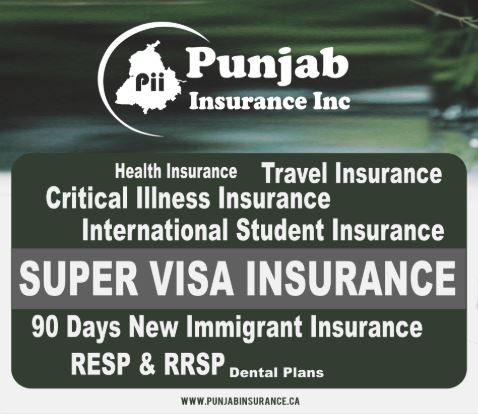









This Super Visa has added a high-quality opportunity for those who aspire to reunite with their parents and grandparents. The most important and obligatory requirement for supervisa is to buy health insurance from a Canadian insurance corporation. Such medical insurance needs to be bought for minimum twelve months.
Anyone applying for the Canadian Super Visa have to show that they've purchased personal medical health insurance that meets the Super Visa requirements, all the Super Visa insurance you bought today ought to meet the following CIC distinct requirements:
Applicants should purchase medical health insurance as a proof earlier than submitting their Super Visa application. Purchasing a medical insurance from us has many benefits.
Remember that it's far the duty of the consumer to get the tentative effective date modified to preserve the policy in impact at the preferred date. The day when your mother and father or grandparents come to Canada, ought to be the first day of coverage safety policy. The 365 days coverage begins from that day. Choosing the date of the insurance coverage isn't very difficult.
We offer flexibility to change the tentative effective date. Dates can be changed by way of virtually calling Varinder Rangi @ +1 416-684-5000
We attempt hard to supply the quality Supervisa Insurance plans at your comfort and help you to examine the insurance and offer you the Insurance prices with the great insurance. We purpose to make your stay the memorable one while you are in Canada.

Life insurance is a contract between the insurance company and insurance policy holder, where company promises to pay fixed amount of money for the beneficiaries and /or estate upon the death of the insured person in exchange for premiums. Premiums can be paid monthly or as a lump sum amount. While selecting the sort of the coverage, numerous elements are taken into consideration along with age, sex, health condition, smoker or non-smoker and the amount one can afford for the premium etc. There are different kinds of coverages available to meet everyone's need.
Benefits of Life Insurance:
The insurer is always having the peace of mind as he or she knows that if something happens to the insurer, the loved ones are not left with any debt or any financial burden.
Term Insurance is the low-cost, temporary insurance protection. It is generally used to meet a temporary need (example - mortgage protection), those who need a large amount of insurance protection but have limited budgets or Individuals with specific business needs, such as business owners who wish to cover the life of a specific employee that has a set number of years until retirement. It can cover immediate needs or may provide future opportunities to move or convert to permanent life insurance without providing medical proof of health. Term plans may be renewable after 5, 10 or 20 years without supporting medical evidence
Permanent life insurance also known as whole life insurance is the protection that is given for the whole life of the insured. It can build equity and have cash value. The premium rates are higher than the term life insurance and are more valuable in the long run.
There are two types of whole life policies:
Universal life insurance is a form of permanent life insurance with some flexibility. Typically it offers flexible amounts of coverage, flexible coverage periods and flexible premiums. With a universal life policy the death benefit can be increased over time based on a certain set percentage. The indexed amount can be based on Consumer Price Index (CPI) or can be a set percentage chosen by the policy holder. This policy contract offers a choice of yearly renewable term (YRT) costs or level cost of insurance (LCOI)
The policy owner can choose a level amount equal to the face amount of the policy or the face amount plus the cash value that has accumulated under the policy. The most flexible component of a universal life policy is the alternatives available for the investment of premium contributions beyond what is used to cover the cost of insurance. This amount forms the cash value of the policy. Some universal life insurance contracts allow the owner to choose how the cash value component will be invested. The choices available can be a Guaranteed Investment Certificate (GIC), money market account, an index fund investment or a segregated fund investment
A universal life insurance policy owner has some choices on the terms of the contract

A Registered Education Savings Plan, or RESP, is an investment vehicle available to parents in Canada to save for their children's post-secondary education. The principal advantages of RESPs are the access they provide to the Canada Education Savings Grant (CESG) and as method of generating tax-deferred income
RESP is the term associated with your child's future. You may easily get different plans. Some of you may be comfortable paying the premiums on a monthly basis. There are some people who wish to put into account whenever they have money. You can start earning interest as soon as you start saving. You can secure the education of your child in this way
An RESP is a tax shelter designed to benefit post-secondary students. With an RESP, contributions (comprising the investment's principal) are, or have already been, taxed at the contributor's tax rate, while the investment growth (and CESG) is taxed on withdrawal at the recipient's tax rate. An RESP recipient is typically a post-secondary student; these individuals generally pay little or no federal income tax, owing to tuition and education tax credits. Thus, with the tax-free principal contribution available for withdrawal, CESG, and nearly-tax-free interest, the student will have a good source of income to fund his or her post-secondary education
The Canada Education Savings Grant (CESG) is provided to complement RESP contributions, wherein the government of Canada contributes 20% of the first $2,500 in annual contributions made to an RESP. After changes introduced in the 2007 Canadian federal budget, the government may contribute up to $500 per year to a participating RESP, to a lifetime maximum of $7,200. This income is available upon withdrawal from the RESP by a post-secondary recipient, with a maximum lifetime contribution of $50,000. Any contributions over this amount are subject to taxation
The government grants introduced in 2005, entitled Additional CESG, allowed an additional 10% or 20% for a total of an extra 30 or 40 cents on each dollar of the first $500 contributed to an RESP, depending on the family income of the beneficiary's primary caregiver. An application is made through the promoter of the RESP, which is often a bank, mutual fund company or group RESP provider

A registered retirement savings plan (RRSP) is an account designed to help Canadians save for retirement. The money in an RRSP can be used to buy a whole host of investments—mutual funds, ETFs, stocks, bonds, and the like. While the investments are held in your RRSP, you won't have to pay tax on any interest, dividends, or capital gains you earn. This makes the decision to open a RRSP a wise one. Funds are usually held in an RRSP until retirement at which time the contributions may be withdrawn or transferred to other investment plans.
RRSP's are ideal for:
When the money is withdrawn from an RRSP, it becomes taxable income. If the income is withdrawn at retirement, the investor's tax rate is usually lower in comparison to his/her peak earning years. The maximum annual tax-deductible contributions to RRSP an individual is per mitted to add into his/her plan must be lesser than the following:
RRSPs can be categorized in different types:
In addition to using the RRSP as a tool to enjoy saving on your taxable income and save for the future, RRSPs may also be used as a “safety net” for unexpected financial emergencies. However, the early withdrawals will be taxed and counted towards your taxable income for the fiscal year.

TFSA is a tax-free saving account, where your contributions and investments are tax-sheltered. It is an ideal solution when you don't want to lock in your funds for a fixed term or interest rate. This means there is no tax applicable on the investment income. This program was started in 2009. Applicants who are more than or of 18 years of age, having a valid social insurance number (SIN), can apply for TFSA. They can set their money aside for future security
Types of TFSAs, offered by the Canadian government:
TFSA can be issued by banks, insurance companies, credit unions, and trust companies
NOTE: An applicant who is not a resident of Canada and is determined to be that for various income tax reasons can still have a valid SIN and is allowed to open a TFSA. But any contributions made while as a non-resident will be subjected to 1% tax for every month the contribution stayed in the account. A holder can have more than one TFSA at any time, but the total amount you contribute to all your TFSAs cannot be more than your available TFSA contribution room for that year
Maximum Contribution Limit for TFSA
The annual limit of contribution to Tax-Free Savings Accounts is set at $5,500 for 2018. The maximum limits for savings in the TFSA account keeps changing. The maximum contribution limit from 2009 to 2012 was $5,000 and $5,500 respectively. For the years 2015 and 2016 it limit was $10,000 and $5,500 respectively. In case the candidate withdraws the amount from TFSA account, the amount withdrawn is added to your contribution room in the next calendar year
Any applicant who is or above 18 years of age with a valid SIN (social insurance number) is eligible to open a TFSA

A visitor to Canada Insurance can provide peace of mind that coverage will be provided to one's family members or friend's visiting to Canada from an outside country for any unforeseen medical emergency expenses during their visit. Few come as a tourist to explore the country. There are few people with an aim of meeting their relatives staying in this nation. Some people visit the place for business purpose. But, all of them are unprotected without coverage. Human beings are very sensitive to the specific surroundings. As a result, there can be chances of health problems once they visit a different country with varied weather condition. Health care costs in Canada are very expensive. Without emergency hospital and medical insurance, visitors to Canada would be responsible for these high costs, which can create a significant financial burden.
This you can purchase if you are a frequent visitor to Canada. This is suitable for people staying in any country. You can get coverage for many conditions. Some of them are:
If you have plans to visit Canada our Visitor Health Insurance is one of the good options for you in such situations. If you have purchased this policy, we are liable to provide maximum facilities. We cover various areas. Following is the list of our coverage:
Some insurance companies apprehend the complex needs of International and Canadian student studying abroad. As a result, some of the most comprehensive Student Medical Insurance programs are offered. Insurance plans that available for both International and Canadian students offer the option for the student to purchase coverage for accompanying or extended family members, under a single policy. Some plans provide additional benefits including academic offerings, maternity advantage, annual doctor visits, accidental death and dismemberment and much more.

Disability Insurance is a form of insurance that can help you to replace a portion of your income if you are not able to work. A disability can result from any reason, it might be sudden or of any degenerative condition. The chance of becoming disabled due to injury or illness during your working years is very high. Disability Insurance could assist you pay the mortgage payments and other bills while you are unable to work. Disability Insurance can help ensure your pay cheque. Your inability to work can risk your family's lifestyle and well-being. To guard your income Disability Insurance provides you a variety of options from which we can help you pick the right one for you.
During your inability, you might even have to withdraw your regular savings, which might disrupt your future plans of retirement or child education. Disability Insurance is a great way to protect your funds. There are different Elimination Periods (EP), (length of time to wait before benefits begin), and different Benefit Periods (BP), (length of time benefits will be payable), that will allow you to choose the plan that best suits your needs. There are a few taxable as well as tax-free Disability Insurance plans. The benefits are paid on the monthly basis Disability Insurance can replace 60% to 85% of your annual income
This coverage begins when at a certain period you are disabled and are unable to earn an income. Most short-term disability proposals pay a proportion of usual earnings, for example, 70 percent up to a definite time span. Normally, this can be around 15, 26 or 52 weeks
This insurance coverage begins when your temporary disability benefits run out. Normally, the objective is to put back 60 to 70 percent of your regular earnings, however, there is always an uppermost dollar sum (e.g., $5000 on a monthly basis). Given this, if you make high revenue, group LTD plans may reinstate below 60 to 70% of your pre-disability revenues up to the age of 70 years.
There is variation in the policies depending on the types of disability e.g. whether the disability benefits are to be received if the insurer cannot perform the duties of his or her occupation or any job. The policy is continued after the person gets recovered from the disability. The benefits could be paid if there is a recurrence of the prior disability or subsequent disability occurs. In simple words, Disability Insurance offers you a simple, affordable way to provide an income should a disability prevent you from working

With such a variety of advancements in medical science, the opportunities of survival and healing from any critical illness like cancer, stroke or coronary heart attacks have improved considerably. The majority of the medical plans have the coverage for the hospital and medical expenses but that might not be enough to pay for the transpiration to the treatment centers, childcare, and others.
Critical Illness insurance provides a lump sum amount that is tax-free if you come across any illness which is covered by the insurance. The lump sum will be received as a cash payment and not as a reimbursement of the costs. Thus it is up to you how you want to spend the money. You can use the Critical Illness Insurance money to pay for private nursing, any medical equipment or even to pay off your mortgage.
Under Critical Illness Insurance Policy, there is a condition, under which you must survive a number of pre-decided days in order to avail the benefit. In simple words, according to some policies, you may have to survive 30 days after your disease has been diagnosed in order to claim the lump sum. It is known as the minimum survival period. You can consider new medical treatments and medications not covered by private or government health insurance plan.
The insured additionally has the selection to pay a further fee and acquire a complete refund of all premiums paid at a predetermined point if no claims have occurred. Most Critical Illness coverage products provide access to the Best Doctors carrier on all their critical illness products. This service affords the patron with get entry to a carrier that directs them to the top North American doctors primarily based on their illness and books them in at reduced fee for appropriate treatment. Critical illness insurance in Canada gives assist paying charges associated with life altering ailments. If you grow to be ill with an illness covered by your insurance and survive the waiting period, you acquire a lump sum tax free.

A Travel insurance is an absolute necessity these days. A travel insurance plan provides assurance that any unexpected medical emergency costs are covered so you can travel worry-free. If you're heading to another province or country your full provincial healthcare plan won't go with you. That means, if you experience a medical emergency away from home, you'll be left to arrange for care and pay for it too.
Features:

Health & Dental Insurance Protect yourself from medical expenses not covered by provincial health insurance. We have many choices to cover prescription drugs, dental care and so much more. We offer a wide variety of health and dental insurance plans for both individuals and families. We are ready to assist employers in designing a plan that caters to your company's individual needs while helping employees manage their health and wellness concerns.
You and your family can have access to the Health and Dental protection you need. The Health and Dental Plan is specially designed for those who are not covered by a group plan
Flexible and affordable, the Health and Dental plan offers four levels of increasing, comprehensive coverage for:
Our Drug and Dental plan also includes benefits like
And the Dental plan does not require completion of a medical assessment
Do you require assistance with Personal, Business, Life, or Investments?
We collaborate with experienced agents in the industry to deliver the most appropriate product and offerings to fulfill your insurance necessities. Punjab Insurance offers coverage and expertise required to get useful, efficient and cost-effective solutions to fulfill your coverage desires.
Punjab Insurance is an impartial insurance brokerage. With our conviction that insurance is clearly beyond the problem of charges, we are dedicated and committed to offering our customers comprehensive coverage solutions peculiar to their needs.
As an idea conceived in 2001 out of the quest of providing succour against eventualities, with rising statistics of injuries, hazards and mishaps occurring from day to day, Punjab Insurance was incorporated in 2006 to meet the rising needs and soothe the lives of affected individuals.
We offer extensive range of products to include but not limited to Life Coverage, Critical Illness Coverage, SuperVisa, Travel, Medical, Health and Accidental Insurance. We have a broad range of insurance merchandise selection that is sure to extensively suit your preference.
Every Punjab Insurance customer's date begins with an assessment of the patron's needs, this is the bedrock to assisting with building a comprehensive and complete coverage plan
To provide a specialized steering and advice to making an investment in diverse coverage schemes
To do what we know how to do best by offering you top-class Insurance advices that is best tailored to cater for your welfare and those of your relatives.


VARINDER RANGI is a competent certified Insurance Adviser who can provide you specialized and excellent steerage and recommendations for Super-Visa, Life and all other insurance related needs.
Out of the numerous merchandise available in the market, an Expert Insurance Broker is a necessity to having a brief and efficient plan to satisfy your reason.
Having decided on Punjab Insurance, I am overtly convinced of our unmatched abilities and dedication to insure you with a best fit from our broad knowledge and experience of great range of available products.
My goal is to provide you with the proper product knowledge which you look for in a Proficient Insurance Adviser.